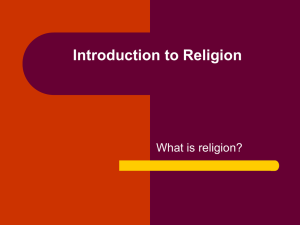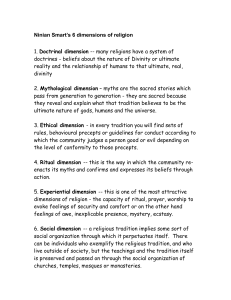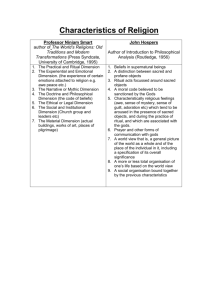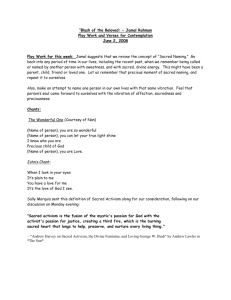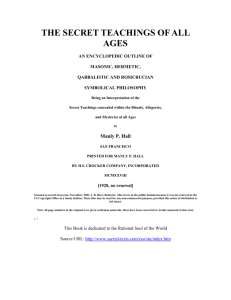Introduction to the Study of Religion
advertisement
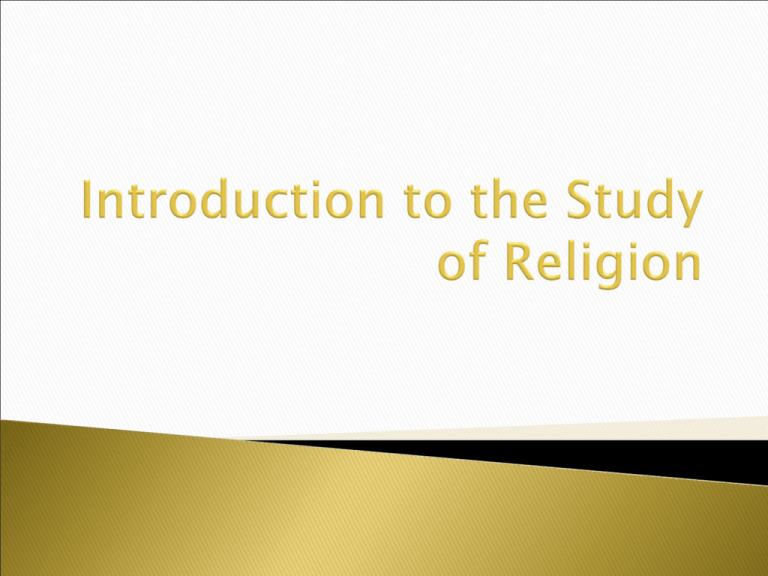
} } Difference between theology and religious studies Western, post-Enlightenment tendency to compartmentalize religion ◦ Religion as an object to be studied rather than as basic to life ◦ Increasing emphasis on rational ways of knowing coupled with skepticism towards divine revelation or personal encounter with divine 1. Materialist View ◦ Religion is a human invention Ludwig Feuerbach (1804-1872) Divine is a projection of humankind’s fears and desires. What we can’t control we attribute to the divine. Sigmund Freud (1856-1939) Religion as wish fulfillment “universal obsessional neurosis”: religion as a collective fantasy; shields us from life’s fears Karl Marx (1818-1883) Religion as the opiate of the masses; can serve as means of manipulation and oppression In place of a better world, we are given a false world of gods and salvations. Religion is an immature response to the world as it really is Many of us saw religion as harmless nonsense. Beliefs might lack all supporting evidence but, we thought, if people needed a crutch for consolation, where's the harm? September 11th changed all that. Revealed faith is not harmless nonsense, it can be lethally dangerous nonsense. Dangerous because it gives people unshakeable confidence in their own righteousness. Dangerous because it gives them false courage to kill themselves, which automatically removes normal barriers to killing others. Dangerous because it teaches enmity to others labeled only by a difference of inherited tradition. And dangerous because we have all bought into a weird respect, which uniquely protects religion from normal criticism. Let's now stop being so damned respectful! 2. Functional View ◦ Religion reinforces social order ◦ Religion serves biological purpose for our species’ survival Nurtures children ◦ Religion provides a stable frame of reference Helps deal with life’s problems e.g. gives people strength during difficult times Strengthens morality Promotes good qualities; discourages bad qualities Gives life meaning Answers our deepest questions 3. ◦ ◦ Faith View: there is an ultimate reality to which we are truly related Religion is a pathway to the sacred Rooted in experience and encounter with that ultimate reality B. Why Study religion? 1. Religion attempts to answer the most basic questions of life: Who are we? Do we have a purpose? Is there something greater than what we can perceive with our senses? 2. The search for the overall meaning of human existence gives voice to human experience 3. The study of religion gives insight into the other Into ourselves/our beliefs Knitter’s telescope 4. Challenges our own paradigmatic assumptions 5. Mutual enrichment 6. Religion and culture/worldview Four types of religious categories explored here Note that some religions, while primarily situated in one category, may involve others 1. Monotheism ◦ Supreme god with ultimate authority ◦ Tends toward personal god; creates and sustains world 2. Polytheism ◦ ◦ ◦ Power shared among many sacred beings May be a supreme god in whom power is concentrated but delegates authority e.g. Hinduism, Daoism, some forms of Buddhism 3. Monism Unity of all reality Behind plurality of forms lies one unified reality If personal gods, they are facets of one sacred reality No distinction between ultimate reality and phenomenal world 4. Nontheism No concept of personal creator God Some forms of Buddhism 5. Pantheism God is ontologically identical with the universe, thus God and the universe are coextensive 6. Panentheism Universe is a manifestation of God; God pervades the universe. Thus, God is greater than the universe, not identical to it as in Pantheism Seven Dimensions of Religion (from Ninian Smart’s The World’s Religions) 1. The practical & ritual dimension 2. Experiential & emotional dimension 3. ◦ ◦ ◦ Ritual Symbols Experience of the numinous Narrative or mythic dimension 4. Doctrinal or philosophical dimension A belief system which gives an explanation of experience Involves analysis, reflection & application What does this mean? What does this mean for our community? What does this mean for me? 5. Ethical and legal dimension Values, codes of behavior; ethics can be codified into law (e.g. Judaism) 6. Social and institutional dimension Provides stability & continuity 7. Material } involves artwork, temples, statues, cathedral, icons, etc. ◦ Sacred places (e.g. river Ganges) } art can be used to symbolize the sacred ◦ pointing us to a reality beyond itself ◦ e.g an icon (see Byzantine art) Two dimensional } Can reveal doctrinal and philosophical assumptions
